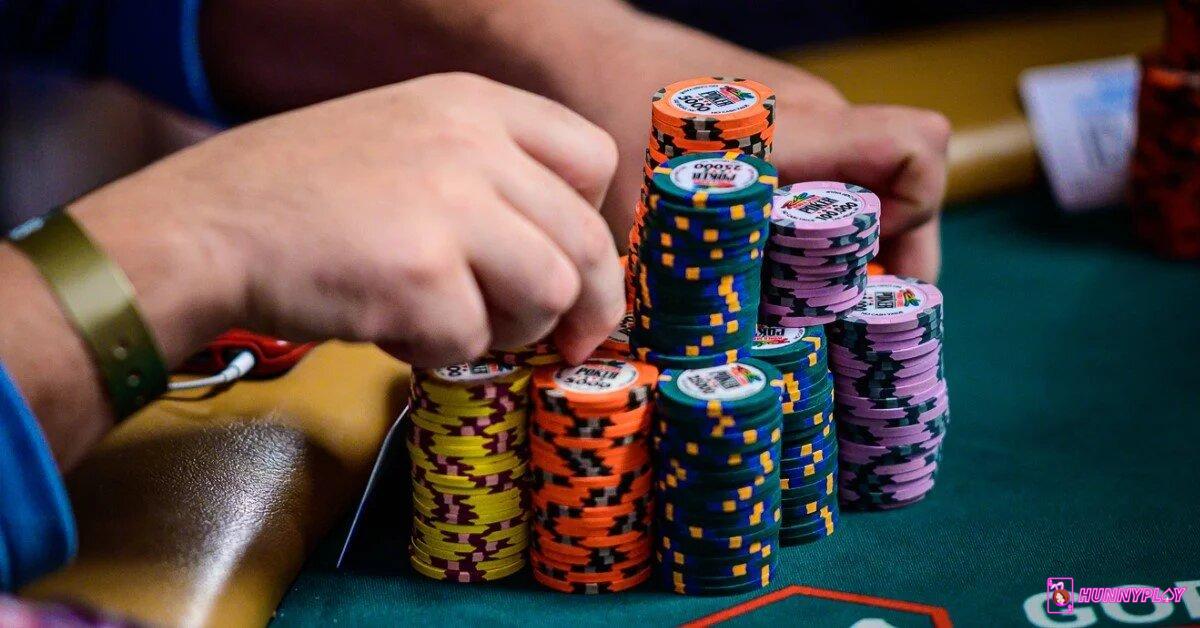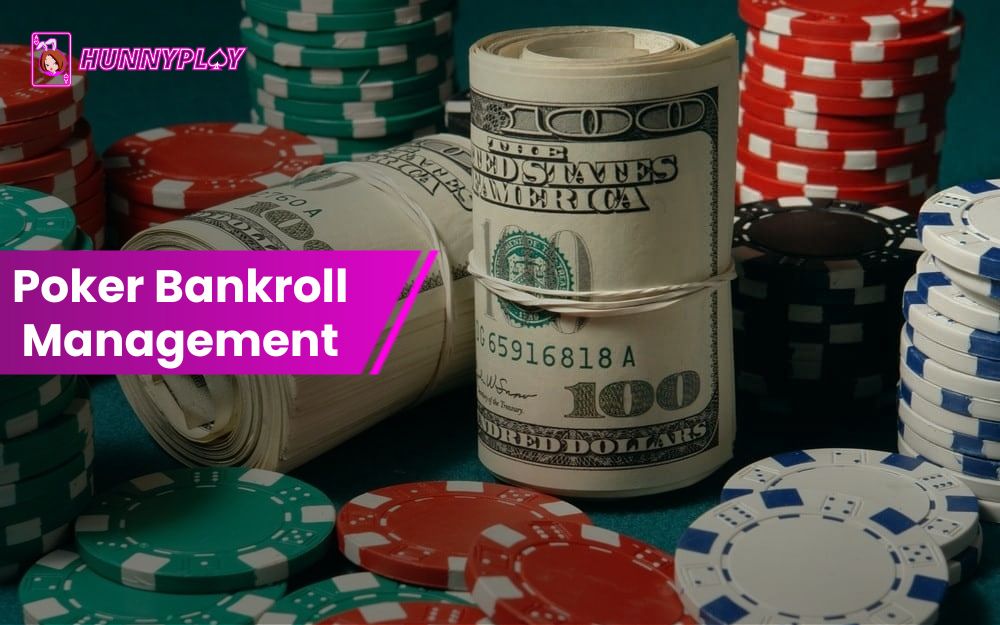If you ask any professional Poker player for their top winning tip, most will emphasize the importance of practicing bankroll management. Curious about what Poker bankroll management entails? Don’t worry; HunnyPlay has all the insights you need to master this crucial skill.
What is Poker bankroll management?
Poker bankroll management is the practice of managing your Poker funds to ensure you can handle the inevitable swings of the game without going broke.
It’s about setting aside a specific amount of money dedicated solely to Poker and establishing rules for how much of that bankroll you’re willing to risk in any given session or hand.
Poker, by nature, is a game of fluctuations. Having an adequate bankroll ensures you can withstand these inevitable ups and downs.
However, advice on the best Poker bankroll management strategy can vary widely.
Here’s a concise guide for you:
- Beginners: Aim for 50 buy-ins for any limit you play.
- Experienced players: A bankroll of 30 buy-ins is usually sufficient.
- Professionals: A robust strategy involves maintaining 100 buy-ins for any limit you play.
Adopting these strategies can help you navigate the financial swings of Poker and achieve long-term success.

Poker bankroll management ensures you can handle the game’s inevitable swings without going broke. (Source: Internet)
Why is Poker bankroll management so important?
Variance is an intrinsic and unavoidable aspect of Poker. The money you can win or lose in a single game—or across multiple games—will always be influenced by this factor. Simply put, variance is what makes Poker a blend of skill and chance.
While you can’t eliminate variance, you can mitigate its effects through effective Poker bankroll management. This involves ensuring your bankroll size matches the stakes you are playing.
If your bankroll is too small, you can’t withstand the game’s natural swings, placing you at a disadvantage. Conversely, if your bankroll is too large for your stakes, you aren’t maximizing your money’s potential.
By managing your bankroll wisely, you ensure your funds are always working for you, maximizing your chances for long-term success in Poker.
What are the basic rules for Poker bankroll management?
There are three fundamental principles of Poker bankroll management that every player should follow:
- Only risk money you can afford to lose: Never gamble with funds needed for essential expenses.
- Play at stakes that match your skill level: Ensure the stakes align with your experience to avoid unnecessary losses.
- Exercise discipline and patience: Focus on steady bankroll growth rather than quick wins.
These core rules form the backbone of effective Poker bankroll management. They are essential for all players, from beginners to seasoned pros aiming to excel in online Poker. Adhering to these principles ensures a sustainable and successful Poker journey.

There are 3 fundamental principles of Poker bankroll management. (Source: Internet)
How variance affects Poker bankroll management?
Variance in Poker measures the deviation of your results from the expected average over time. It represents the element of luck that causes short-term fluctuations, even when you make the right decisions based on skill.
Understanding and managing variance is crucial for Poker players. It helps maintain a proper mindset, avoid tilt (emotional reactions to losing), and implement effective Poker bankroll management strategies to withstand the inevitable swings in fortune.
Here’s how it works:
- Lower win rate: More frequent losing sessions.
- Higher win rate: Fewer losing sessions.
Most Poker winners, who are a minority, have a win rate close to zero. This means their variance is high, and they can’t easily absorb bad beats due to minimal winnings.
Traditional advice suggesting 20 buy-ins for cash games is outdated. Modern cash games, even at low stakes like 1c/2c, 2c/5c, and 5c/10c, have tightened up, making high win rates like 20bb/100 unrealistic unless you table and site select like pros.
Consequently, considerable downswings, such as 20 buy-ins, are common, even in small games. If your bankroll consists of only 20 buy-ins, a single downswing could wipe it out.
To avoid this, ensure your bankroll is robust enough to handle these inevitable fluctuations, ensuring long-term success in today’s competitive Poker environment.
The relationship between Poker bankroll management and psychology
Psychologically, it’s far easier to handle Poker’s inevitable ups and downs when you know that even a bad day will only slightly dent your Poker bankroll management.
Variance is one of the most challenging aspects for new and struggling players to cope with. We recommend maintaining a substantial cushion to lessen the mental strain during a rough patch.
Some might argue to just reload after losing. However, we disagree with this philosophy.
We believe that going “broke” playing Poker is psychologically damaging for a winning player. By definition, a winning player should only be withdrawing money, not depositing it.
For those just starting with online Poker and managing a small win rate, our advice is to keep a large bankroll (50 buy-ins per limit) and progress slowly.
It’s essential to do it right from the beginning, rather than rushing up the limits and facing consequences later.

Psychology plays a crucial role in bankroll management strategy when playing Poker. (Source: Internet)
Some important aspects of Poker bankroll management strategies
Building a Poker bankroll
The goal is not to build a bankroll as quickly as possible, but to do so at your own pace. It’s not a race to accumulate dozens of buy-ins. Focus on playing your best Poker and improving your skills. You also can use the best Poker strategy books and to your advantage.
Grinding micro-stakes and gradually adding a few big blinds to your bankroll might seem tedious, but progress is progress. Every bit helps to improve your win rate per 100 hands.
Occasionally, it’s okay to take a shot at higher stakes. To “take a shot” means playing higher than your Poker bankroll management strategy usually allows. As long as this risk involves a small portion of your bankroll, you can do it without the fear of going broke.
This balanced approach ensures steady growth and long-term success in building your Poker bankroll management.
Poker bankroll management keeps you in profitable games
Managing your Poker bankroll involves more than just depositing a lump sum into your online Poker account. The size of your bankroll dictates the stakes you can afford to play, ensuring you stay within your financial limits.
Every Poker player dreams of climbing the stakes ladder to win more money. However, few plan for the possibility of dropping down to lower stakes.
Being realistic and moving down, or lowering your average buy-in, is vital for long-term success in Poker.
Using your bankroll to determine your playing level ensures you remain in profitable games. Effective bankroll management means adjusting your stakes based on your performance.
If you experience a losing streak, moving down in stakes helps preserve your bankroll. Once you start winning again, you can rebuild your bankroll and move back up.
Ultimately, proper bankroll management helps you find your sweet spot—games where you are consistently profitable and can sustain your success without frequently needing to drop down in stakes.
Your Poker bankroll management prevents you from going broke
One key purpose of Poker bankroll management is to provide a cushion for inevitable losses, even for the best players.
For example, sitting down at a $0.10/$0.25 cash game with only $25 in your bankroll means losing one buy-in can knock you out of the game.
If you can’t afford to replenish your bankroll, you might be sidelined from Poker for a while. However, having multiple $25 buy-ins allows you to stay in these cash games, attempt to recoup losses, and improve your win rate.
Proper bankroll management eliminates the risk of going broke by prompting you to move down in stakes if you lose a predetermined amount.
Ensuring you have enough buy-ins for your games is essential. Remember, it’s better to play at the smallest stakes than to be unable to play at all.
Your POKER bankroll is for POKER only!
It’s essential to understand that your Poker bankroll management should consist only of money you can afford to lose.
This is a fundamental rule in no-limit Texas Hold’em and any other Poker variant. The funds allocated to your Poker bankroll should be exclusively for Poker and not needed for other expenses.
If you believe you have a $2,000 bankroll but plan to use $1,500 of it for an important bill soon, your actual bankroll is only $500.
It’s critical that none of your Poker bankroll is earmarked for other uses because if it is, you’re gambling with money you can’t afford to lose.
This is a cardinal sin in all forms of gambling, including online Poker. Always keep your Poker money separate to minimize any significant risks to your living expenses and ensure you’re playing responsibly.
Starting a Poker bankroll management with no money
Some players opt to start with no funds and attempt to build a bankroll from scratch. They sign up for online Poker sites and participate in freeroll tournaments, which are free to play.
Any winnings from these games are used to gradually build their bankroll.
Chris “Jesus” Ferguson, a famous Poker player, turned $0 into $10,000 over 18 months. He spent nine months grinding freeroll tournaments and the lowest stakes cash games to reach $100, then another nine months to achieve his $10,000 goal.
Remarkably, Ferguson even reached $28,000 at one point, solely from his time, effort, and determination.
While this is a valid Poker bankroll management strategy, there are more efficient tools and methods available today to maximize your Poker investment returns.

If you’re a beginner, start building your poker bankroll from scratch. (Source: Internet)
Poker bankroll management FAQs
Q: What’s a good bankroll for Poker?
A: A solid rule of thumb for cash players is to have a bankroll of at least 20 buy-ins, although some players prefer 40-50. For example, if you plan to play NL10 (with $0.05/$0.10 blinds) and the maximum buy-in is $10, you should ideally have at least $200 in your account.
Q: What is the rule of thumb for bankroll in Poker?
A: The general guideline for a cash-game bankroll is to never have more than 5% of your total bankroll in play at any given time. This translates to a minimum of 20 buy-ins for single-table cash games and more for multi-tabling. For tournament settings, it is recommended to have over 100 buy-ins for the tournaments you wish to enter.
Q: What is the bankroll for a professional Poker player?
A: For beginners, the best strategy is to maintain a bankroll with 50 buy-ins for any limit you’re playing. Experienced players can manage with 30 buy-ins, while professional Poker players should use a strategy involving 100 buy-ins for any limit they play. This approach helps sustain their game and manage variance effectively.
Conclusion
After all, effective Poker bankroll management is crucial for long-term success. It involves maintaining a sufficient bankroll, managing variance, and keeping funds dedicated solely to Poker.
By following key principles like having enough buy-ins and adjusting stakes based on performance, players can avoid going broke and stay in profitable games.
For comprehensive Poker strategies and tools, visit HunnyPlay and take your game to the next level.





















